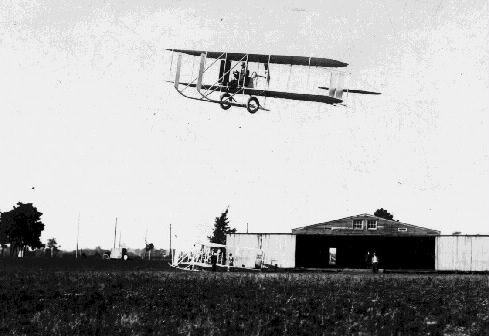Jane's All The World Aircraft 1913
U.S.A. AEROPLANES.
WRIGHT BROS. Biplanes. The Wright Co., Dayton, Ohio. The original type of Wright machine was mounted on skids only, and started along a rail. Its special features were a biplane elevator forward, main planes with warpable tips to trailing edge, small keel in gap, 2 propellers, chain driven in rear of planes, double rudder in rear and no tail. Wilbur Wright flew a machine of this type for 2 h. 20 m. 23? s. in 1908. (Details of early Wrights see previous editions of this book.)
Model and date. B. C. EX. E.
Length......feet(m.) 31 (9.45) 29? (9) ... ...
Span........feet(m.) 39 (11.90) 38 (ll.58) 32 (9.75) 32 (9.75)
Area...sq. feet(m?.) 500 (47) 500 (47) ... ...
Weight,
total...lbs.(kgs.) 1250 (567) ... ... ...
useful..lbs.(kgs.) ... ... ... ...
Motor..........h.p. 30-35 Wright. 30-35 Wright. 30 or 50 30 or 50
Wright. Wright.
Speed....m.p.h.(km.) 45 (75) 45 (75) ... ...
1913 standard. For exhibition 1913
This machine work only. For
as a hydro is Single seater exhibition
fitted with small duplicate work
two 3 step of B. only.
floats. Single seater
duplicate of
EX except
fitted with a
single pro-
peller only.
Журнал Flight
Flight, January 3, 1914.
AEROPLANE TYPES.
THE MODEL E WRIGHT BIPLANE.
SOME little time ago the Wright Factory at Dayton turned out a new type of biplane specially designed for exhibition work, which has given very satisfactory results in the air. It more or less follows the usual Wright practice, the only way in which it differ, being that a single propeller is employed instead of the two that have previously characterised these pioneer machines. There are, of course, several differences in constructional details necessitated by the new method of propulsion. One important feature consists of the rapidity with which it can be dismantled and vice versa. The planes are built up in three sections or panels, the centre one of which is carried on the chassis and bears the pilot and power plant. The latter consists of a water-cooled 30 h.p. 4-cylinder Wright motor, which is mounted on the lower plane alongside the pilot, on his right, and driving a seven-foot propeller by means of a single chain and a short length of shaft. The propeller is centrally situated at the rear of, and midway between the top and bottom planes, and its shaft is supported by a strut and three steel tie rods. The tail is carried by two pairs of V outriggers connected to the rear spar so that they are clear of the propeller. The tail is of the orthodox Wright pattern, consisting of a single elevator plane with a flexing trailing edge and a pair of directional rudders. Right in front of the machine are two "blinkers," which differ from those on other Wright models in that they are constructed of wood and are rigidly fastened at the bottom to the extremities of the skids. They are connected at the top by a thin tie rod, and the only other bracing required is a pair of diagonal wires from one to the other. The two outer cellules or panels are very easily detached from the centre one, the time taken to dismantle the machine for transport being well under fifteen minutes. The principal dimensions of this machine are:- Span, 32 ft.; overall length, 28 ft.; chord, 5 ft. 1 in.; supporting area, 316 sq. ft.; weight ready for the air, 730 lbs.
"VEE JAY."



